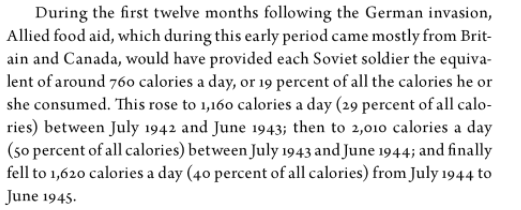Western Aid for the Soviet Union During World War II: Part II by Denis Havlat:
During World War II the Soviet Union received large amounts of aid from the Western world in the form of supplies and military intervention, both of which were declared to have been irrelevant for the Soviet Union’s victory over Nazi Germany by Soviet historians. This article examines the claim made by Soviet historiography, and it comes to the conclusion that both Western supplies and military intervention were far more helpful than claimed by the Soviets.
Without this aid the Red Army would not have been able to perform as well as it did historically, tilting the balance in Germany’s favor. Soviet claims about the irrelevance of Western aid can thus be dismissed as propaganda and inaccurate.
The USSR and Total War: Why Didn’t the Soviet Economy Collapse in 1942? by Mark Harrison:
Roosevelt also contributed to Soviet stabilization. The first installment of wartime Allied aid that reached the Soviet Union in 1942, although small by later standards, amounted to some 5 per cent of Soviet GNP in that year. Although Allied aid was used directly to supply the armed forces with both durable goods and consumables, indirectly it probably released resources to households. By improving the balance of overall resources it brought about a ceteris paribus increase in the payoff to patriotic citizens. In other words, Lend-Lease was stabilizing. We cannot measure the distance of the Soviet economy from the point of collapse in 1942, but it seems beyond doubt that collapse was near. Without Lend-Lease it would have been nearer. Stalin himself recognized this, although he expressed himself more directly. He told Khrushchev several times that the Soviet Union had suffered such heavy losses that without Allied aid it would have lost the war.19
Boris V. Sokolov (2007).
The role of lend‐lease in Soviet military efforts, 1941–1945, The Journal of Slavic Military Studies: Vol. 7, issue 3, pages 567-586:
In general, we can conclude that without Western supplies, the Soviet Union not only could not have won the Great Patriotic War, but was not even able to resist the German invasion, not being able to produce a sufficient amount of weapons and military equipment and provide it with fuel and ammunition. This dependence was well understood by the Soviet leadership at the beginning of the war. For example, the special envoy of President F.D. Roosevelt, G. Hopkins, reported in a message dated July 31, 1941, that Stalin believed it was impossible without American assistance from Great Britain and the USSR to resist the material might of Germany, which had the resources of occupied Europe. {70}Roosevelt, back in October 1940, announcing his decision to allow the military department to provide weapons and equipment that are surplus for the needs of the American armed forces, as well as strategic materials and industrial equipment to those countries that could protect American national interests, allowed the inclusion of these countries and Russia. {71} Without such an attitude on the part of the president, the pre-war placement in the United States of Soviet orders for equipment important for the production of weapons and military equipment would hardly have been possible.
Hunger and War: Food Provisioning in the Soviet Union during World War II:
tl;dr the Soviets are defeated in the 1941-1943 timeframe, exact date depending on personal interpretation and actions all parties (Nazis, Anglo-Americans and Soviets themselves) take in the emerging strategic situation. My own is that the Soviet war effort is crippled in 1942, and the Nazis deal the death blow by 1943 by occupying the A-A Line; Urals Line follows by 1944 with an effectively minimally opposed advance reminiscent of early 1918.


